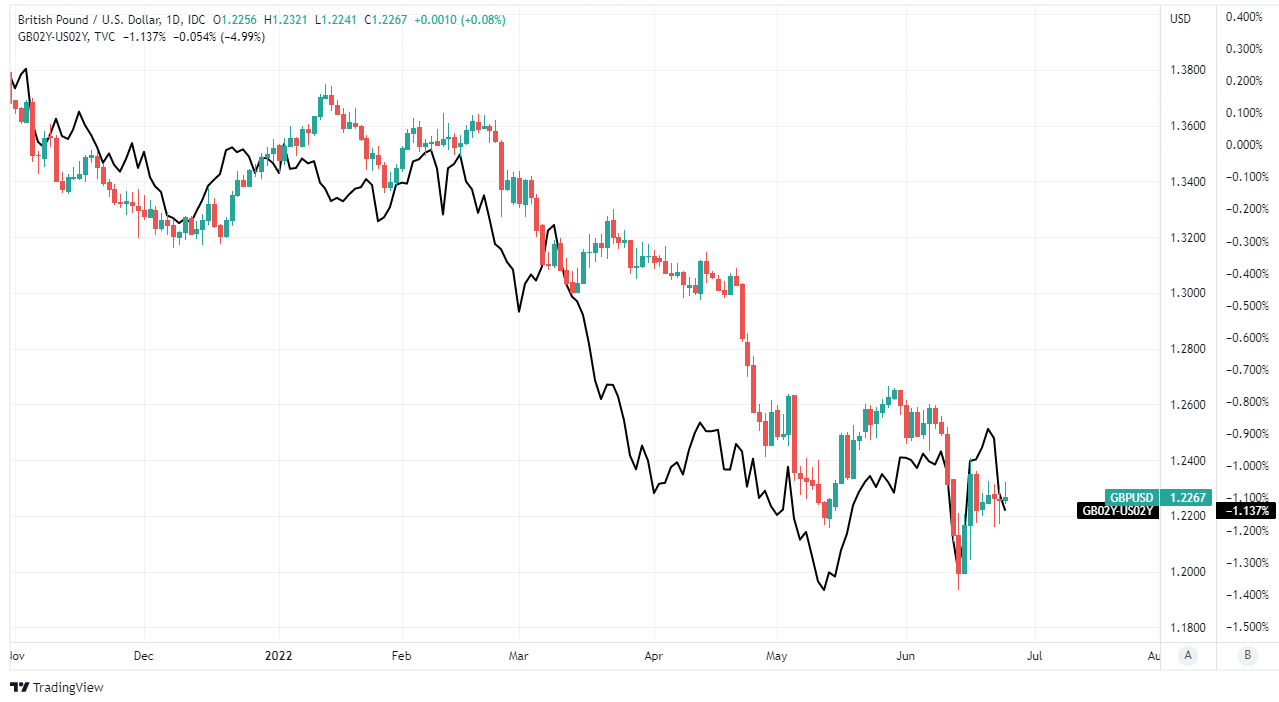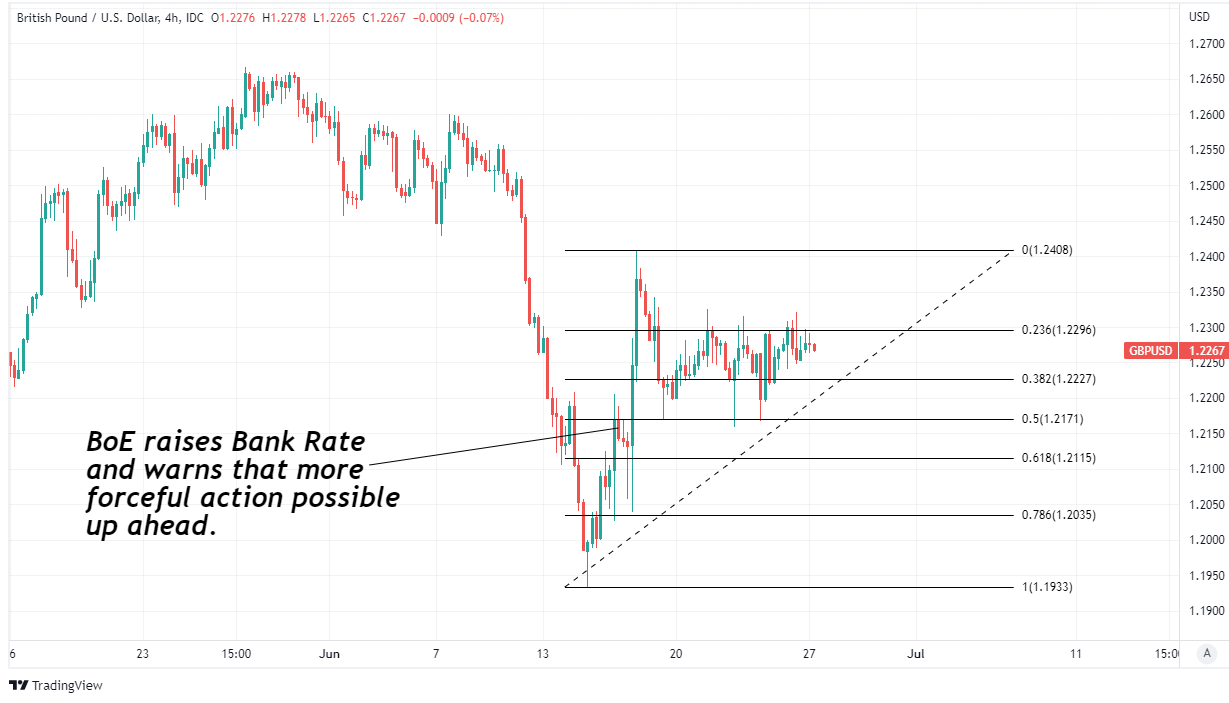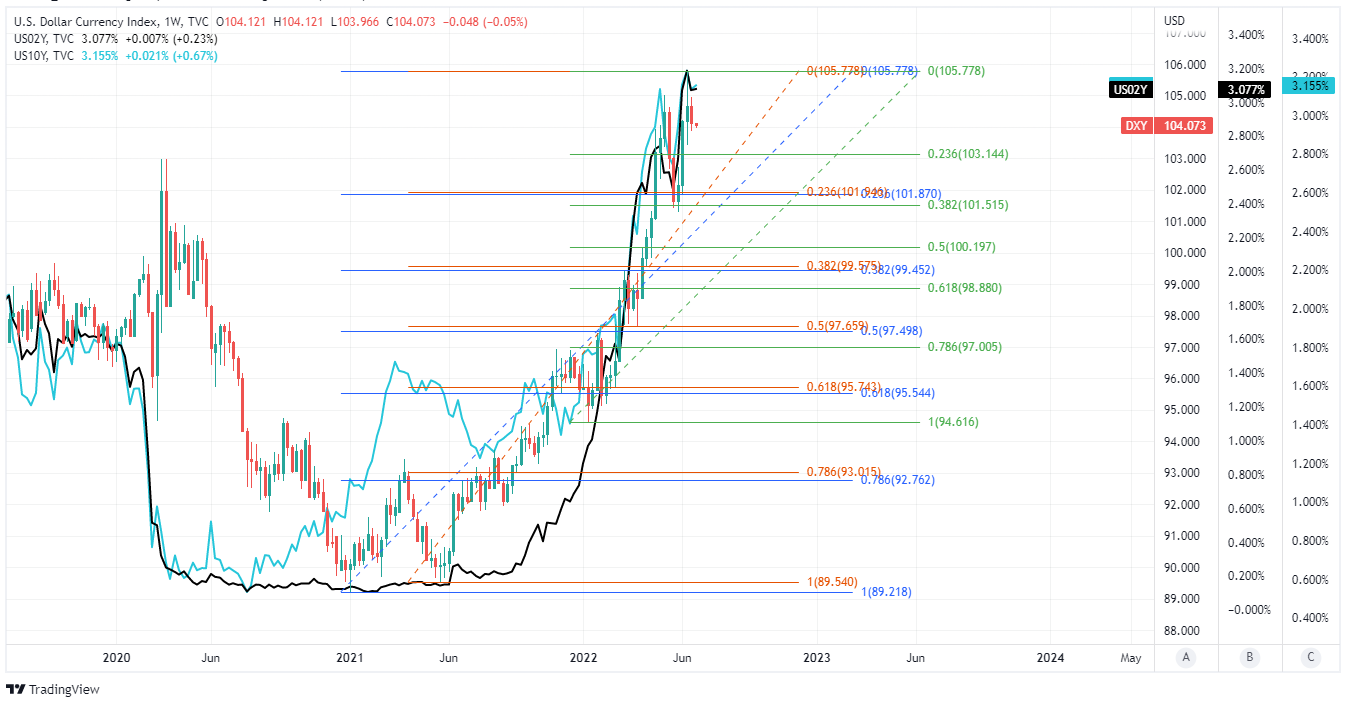GBP/USD Week Ahead Forecast: Supported at 1.2171 as U.S. Data Dominates
- Written by: James Skinner
-
- GBP/USD supported above 1.2171 short-term
- But struggling for momentum once above 1.23
- Range trade likely without further USD retreat
- U.S. data in focus as UK’s calendar falls quiet

Image © Adobe Images
The Pound to Dollar exchange rate has clung onto much of the gain made in the wake of June’s Bank of England (BoE) policy decision but without any further corrective decline by the Dollar, Sterling could be likely to consolidate within roughly a 1.2171 to 1.2323 range during the week ahead.
Sterling drew bids from the market near or below 1.22 last week after appearing to benefit from signs of a more hawkish lean in the BoE’s monetary policy stance as well as what was, for the most part, a softer U.S. Dollar.
The Dollar eased lower against most major currencies last week even as financial markets revised down their expectations for interest rates at the Federal Reserve (Fed), Bank of England and many other central banks amid a palpable increase in market concerns about the global economic outlook.
“Range-trading throughout all of this week provides us with little in terms of technical guidance but the GBP’s failure to hold above 1.23 suggests near-term upside is limited after an unsuccessful test of 1.24 last week Wednesday,” says Juan Manuel Herrera, a strategist at Scotiabank.
“Support is the intraday low of 1.2240 followed by 1.2220 and the big figure. Resistance after the 1.23 figure zone and 1.2324 is the mid1.23s,” Herrera and colleagues also said on Friday.
Above: Pound to Dollar exchange rate shown at 4-hour intervals with Fibonacci retracements of June rebound indicating possible short-term areas of technical support for Sterling. Click image for closer inspection.
Market-implied expectations for the midpoint of the 25 basis point wide Federal Reserve interest rate at year-end fell from 3.45% to 3.36% last week while the equivalent number for the end of 2023 declined from 3.3% to 3% last week.
By many analyst accounts the fall in market expectations was due to remarks made by Fed Chairman Jerome Powell, who told Congress that it will be difficult for the Fed to bring down inflation without disrupting the labour market or harming the economy.
“In other words, achieving a soft landing is not going to be easy. He said it is not the Fed’s intention to cause a recession but acknowledged that it was a possibility,” says Tom Kenny, a senior economist at ANZ.
“A growing chorus of Fed officials are leaning toward another 75bp hike at the 26-27 July FOMC meeting. We expect an elevated June CPI print (due out 13 July) will see the Fed repeat June’s move,” Kenny also said on Friday.
Chairman Powell merely reiterated remarks already made in the press conference following June’s decision to lift the Fed Funds rate by a large 0.75% increment, taking it up to 1.75%, although they had a much more palpable impact on stock and bond markets last week than on their first iteration.
 Above: Pound to Dollar rate shown at daily intervals with spread or gap between 02 year UK and U.S. government bond yields. Click image for closer inspection.
Above: Pound to Dollar rate shown at daily intervals with spread or gap between 02 year UK and U.S. government bond yields. Click image for closer inspection.
The Dollar eased lower following the testimony, helping the Pound to Dollar rate to remain supported above the 1.22 handle in the process and despite a series of UK economic numbers also forcing markets to crimp expectations for the BoE’s Bank Rate at year-end.
“The UK June PMIs surprised on the upside staying flat compared to a month before, with the release gaining more importance given the sharp contrast with the eurozone and US figures,” says Chris Turner, global head of markets and regional head of research for UK & CEE at ING.
“GBP/USD may stay in the 1.22-1.23 range for now, while EUR/GBP may keep inching lower towards the lower half of the 0.8500-0.8600 range,” Turner and colleagues also said on Friday.
The Dollar’s declines last week were in contrast to its typical reaction to market concerns about the global economic outlook and many analysts do still anticipate that it would benefit from any further deterioration.
“The [Dollar Index] can track higher to 106pts this week. The growing risks of a global recession, or at least a sharp slowdown, supports further gains in the USD,” says Joseph Capurso, head of international economics at Commonwealth Bank of Australia.
Above: U.S. Dollar Index at weekly intervals with Fibonacci retracements of various uptrends indicating possible areas of short and medium-term technical support, and shown alongside 02-year and 10-year U.S. government bond yields.
“Without any important UK economic data scheduled, a stronger USD will likely be the major influence on GBP/USD. There is downside support for GBP/USD near 1.2211,” Capurso and colleagues also said on Monday.
All of this leaves a lot to be determined this week by the flurry of important economic figures due from the U.S. over the coming days, which includes the May edition of the Fed’s preferred measure of inflation; the Core Personal Consumption Expenditures Price Index.
Consensus expects the Core PCE Price Index to rise by 0.4% for last month, up from 0.3% previously, but to fall from 4.9% to 4.8% in annual terms.
“Not all of the strength in the core CPI (eg. airfares, motor vehicle insurance) will feed through to the core PCE deflator,” says Kevin Cummins, chief U.S. economist at Natwest Markets.
“We expect the core PCE deflator to advance by 0.4% (0.383% unrounded), firmer than the string of 0.3% gains in the prior three months but still less than the 0.6% gain in the core CPI. On a year/year basis, a realization of our forecast would pull the core PCE inflation rate down from 4.9% in April to 4.7% in May as the 0.6% surge from last May falls out of calculation,” Cummins said on Friday.












